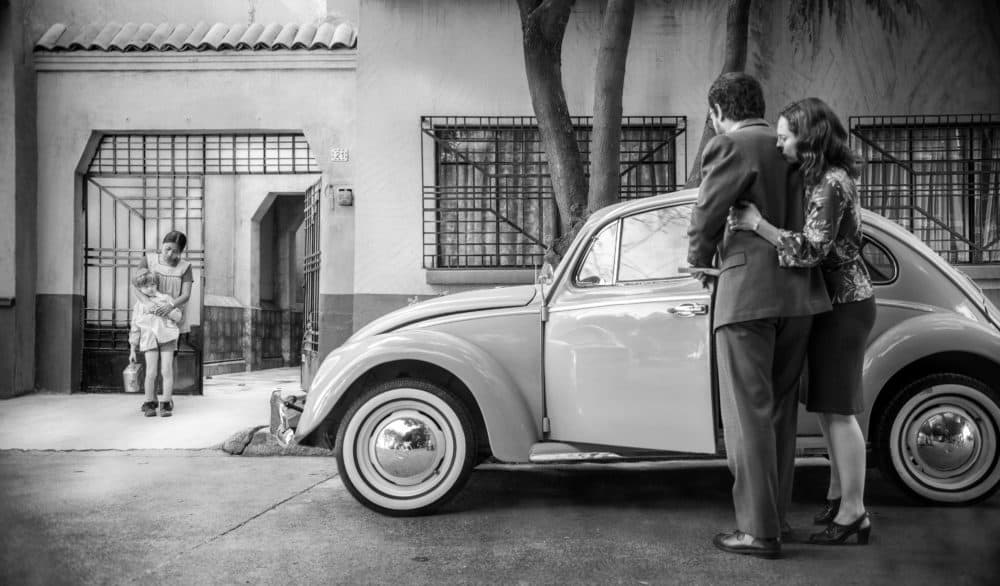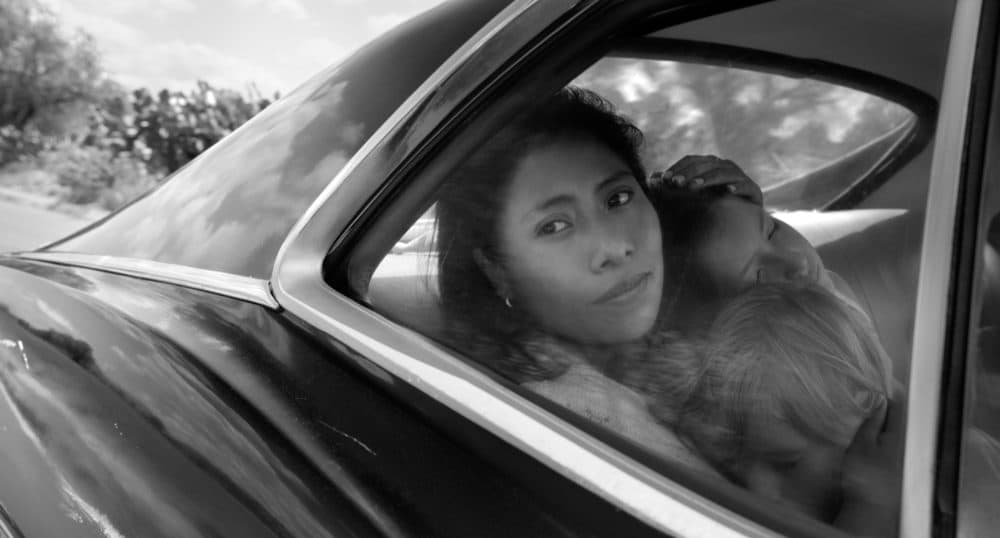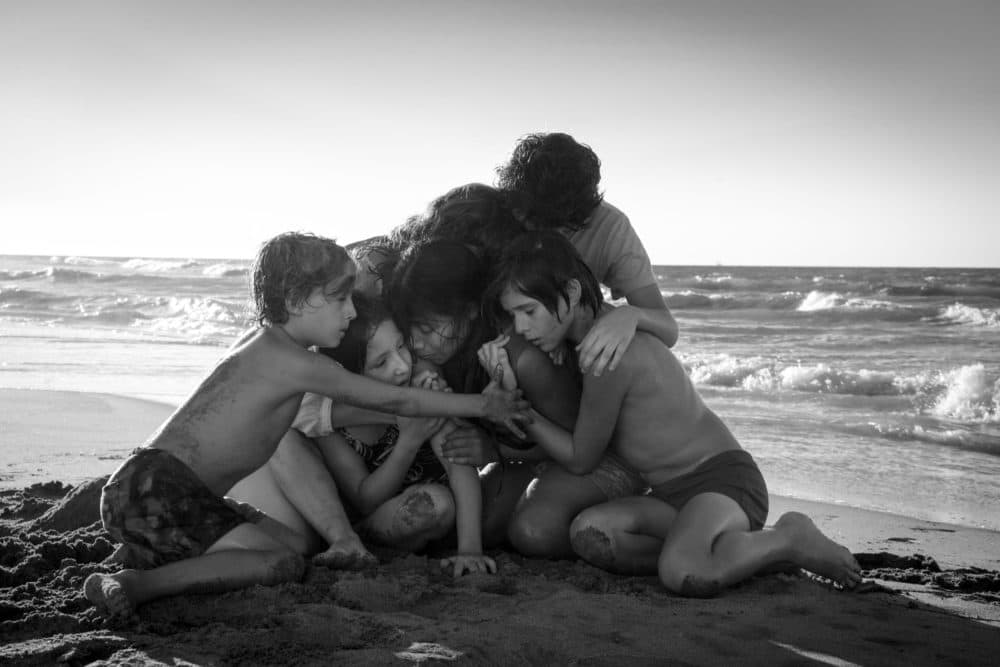Advertisement
Review
'Roma' Turns An Intimate Memory Story Into A Marvel Of A Movie

Writer-director Alfonso Cuarón’s "Roma" is a technical amazement, a feat of scene choreography and production design bordering on the super-heroic. Photographed in crisp, deep-focus, black-and-white digital widescreen, every frame is a painting and every shot an obstacle course.
The movie is a marvel of bustling background action, bringing Mexico City circa 1971 to boisterous life in such painstaking detail these poor characters in the foreground probably never had a chance. “Roma” is a minimalist family melodrama overwhelmed by the gargantuan scale of an epic. Half the time I felt like I was watching it through the wrong end of binoculars.
I think this might be part of the point. Cuarón is no dummy, and his 2006 masterpiece “Children of Men” may or may not be the greatest film of the aughts, but there’s no denying it’s the most eerily prescient, positing a xenophobic London trying to Brexit itself off during a semi-apocalyptic refugee crisis. It’s one of those movies that changed the way movies are made, with Cuarón and cinematographer Emmanuel Lubezki unleashing a barrage of breathtaking, single-take action sequences that an entire generation of filmmakers has been ripping off ever since to increasingly diminishing returns. (The “my tracking shot is longer than yours” measuring contest continues to be an epidemic in Directors Guild locker rooms.)
“Roma” employs the same staging as the battle of Bexhill in “Children of Men” for scenes in which characters go out shopping or to the movies. The overblown disconnect is presumably intentional. For this is at heart a modest memory piece — a slice of everyday life based on the filmmaker’s own childhood — with most of the focus on his upper class family’s indigenous maid Cleo, played quite movingly by first-time actress Yalitza Aparicio.

Cleo tends to a rambunctious brood whose mother (Marina de Tavira) is knocked for a loop when their rich physician dad’s “research trip to Québec” stretches out indefinitely. (No points for guessing what he was really researching.) Meanwhile our maid is seduced and abandoned by a martial arts-practicing wannabe student revolutionary, left pregnant and without prospects. There’s not much in the way of plot to be found in “Roma,” but plenty of silent, serene suffering on Aparicio’s part amid spectacular set pieces in a noisy, chaotic world that seems to be bursting apart at the seams.
I assume the movie’s massive scale is the filmmaker’s way of paying tribute, granting Cleo’s small story a vast canvas. But the proportions never really clicked for me, too often losing sight of the character amid the grandeur of her surroundings. Cuarón always utilizes the longest, most visually extravagant route into even the simplest of scenes, and after a while the self-conscious virtuosity becomes overbearing. (It feels like taking an aircraft carrier to go around the corner to CVS.) Eventually I found myself longing for a boring old two-shot where people just talked to each other.
The movie is named for the Colonia Roma neighborhood in Mexico City, but Cuarón is also paying homage to the Italian masters of cinema, with plenty of nods to Roberto Rosselini’s “Rome, Open City” and the luxuriant visuals of Luchino Visconti. Of course the influence looming largest is that of Federico Fellini, who himself once made a film called “Roma,” and this tribute uncomfortably splits the difference between the maestro’s early neorealist dramas and his later, deliberately artificial extravaganzas.

“Roma” was photographed by Cuarón himself on a 6K digital camera called the Arri 65, which has been confused for 65 mm film by so many critics and publicity people that this misconception has practically become part of the movie’s marketing campaign. But in actuality this is the same rig that was used to shoot “The Revenant” as well as the Melissa McCarthy comedy “The Boss.” So yes, “Roma” is a ravishing-looking picture, but it’s proudly and unmistakably digital.
Cuarón has employed a theoretically immersive, unconventionally discrete, 360-degree sound mix that isolates dialogue and sound effects according to the camera’s POV. So when a character is on the right side of the screen you’ll only hear them via the right speaker, which becomes awfully jarring when he cuts to a reverse shot mid-sentence and suddenly the voice is only on your left. Even if you don’t know much about sound you’ll quickly come to understand why most movies tend to mix things for the center channel.
Speaking as a longtime, hardcore fan of Cuarón — I even adore his oft-ridiculed, totally ‘90s “Great Expectations” adaptation starring Ethan Hawke and Gwyneth Paltrow — it brings me no pleasure to say that such filigrees feel a bit like he’s getting in his own way. Upon second viewing, “Roma” most reminded me of those early 1980s Francis Ford Coppola movies when he disappeared up his own production design.
Don’t get me wrong, there’s much to admire here, from Aparicio’s tranquil, troubled gaze to the rare, stereotype-confounding sight of wealthy Mexicans in a movie. But there’s also an unbecoming strain that grows wearying, especially in service of such a tiny tale. “Roma” is a good film that would be even better if it wasn’t trying so hard all the time to be a masterpiece.
"Roma" is screening at the Kendall Square Cinema and will be streaming on Netflix starting Dec. 14.
